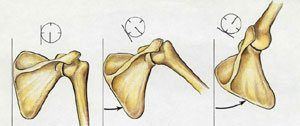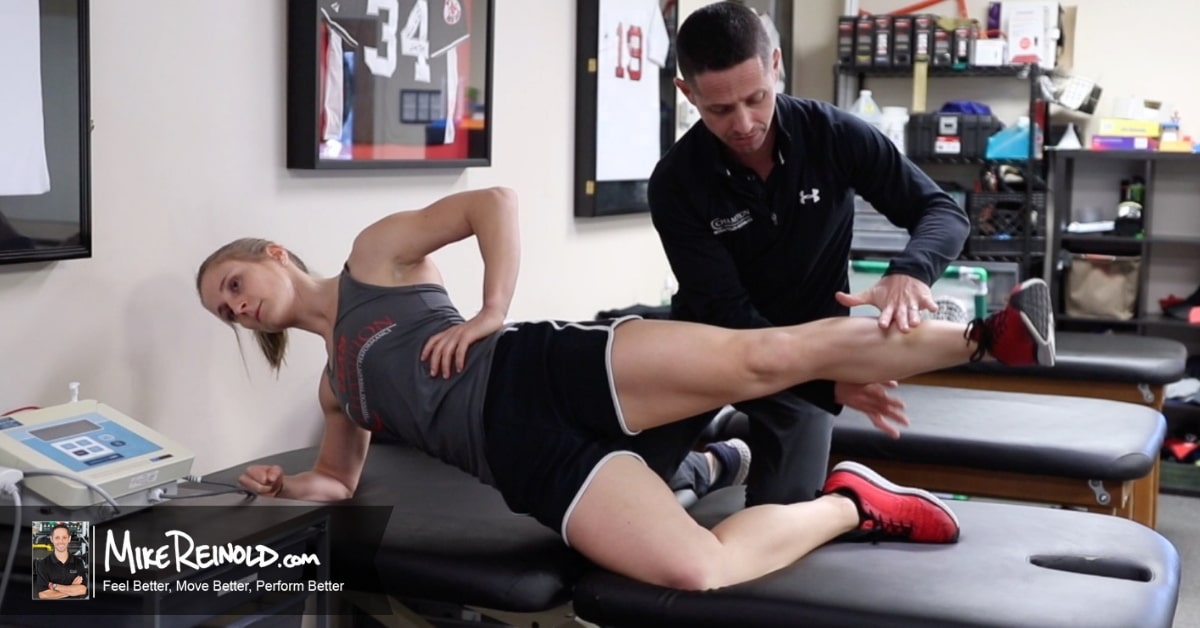Scapula exercises are very common and usually a needed component to any rehabilitation or corrective exercise program. Like anything else, there seems to be a few commonly accepted themes related to scapular exercises that many people take for hard fast rules. No program is right everyone! Here are 3 myths of scapular exercises that I thought would good to discuss.
Pinch Your Shoulder Blades Together
Pinch your shoulder blades. Squeeze your scaps together. Retract your shoulders back. Pack your scapula. These are all common coaching cues given during scapular exercises. The goal of all of these concepts is essentially to get into better posture and “set” your scapula back, ultimately resulting in better posture and better movement patterns when performing exercises. Given that as a society we have an abundance of people with posture. The classic Upper Body Cross Syndrome of forward head, rounded shoulders.
Normal scapulohumeral rhythm requires a sequence of shoulder and scapular movement simultaneously. Pinching your shoulder blades together is essentially contracting your middle trapezius to fully retract your scapula and then move your arm. While this isn’t nearly as bad on shoulder mechanics as lifting your arm in a fully protracted position, I don’t think it is most advantageous to lift your arm in a fully retracted position. By holding your scapula back, which is essentially performing and isometric trapezius contraction, you are likely limiting the normal protraction and upward rotation that occurs with arm elevation and movement.

If the goal of this common coaching cue is to improve posture and improve mechanics while exercising the arm, maybe a better cue would be to instruct thoracic extension. Perhaps even combine this thoracic extension with upper cervical extension such as when performing the chin nod with postural exercises like we talked about recently. This truly improves your posture. Realize that you can still have a very kyphotic and rounded thoracic spine and retract your scapulas. Retracting the your scapulas isn’t a bad visual, but the goal is to really get your thoracic spine extended.
Work on Mobility and Strength to Improve Scapular Symmetry

First let’s take a step back and get something out of the way. Your scapulas are not symmetrical. The vast majority of people are not symmetrical and I would bet even people that are close have subtle differences. The fact is, we are unilateral creatures. We are typically one hand dominant and we typically function with predominant movement patterns that are related to this. This tends to really become an issue when we start to talk about people that perform a repetitive unilateral activity all day. I’m not just talking about athletes like baseball pitchers, you sitting there at your computer using your mouse in your right hand counts too.
This inherently creates asymmetries throughout the body, including the hips, spine, rib cage, and of course the scapula.
In my opinion, scapular position is more related to rib and thoracic position than anything else, including tight muscles and weak or inhibited muscles. The scapula rests on the rib cage and thus moves with the rib cage. Do you need to work on these muscle imbalances? Absolutely. However, proper alignment is needed as well and should be assessed first.
Everyone says “mobility before stability,” right? Well, I’d like to add to that. How about this:
Alignment before mobility before stability.
Perform Scapular Exercises Bilaterally
Ah, the old YTWL exercises. I’ve discussed why I really don’t do a lot of the classic YTWL exercises either prone off the table or on a physioball. I don’t love the upper trap activity needed to stabilize the head and just don’t feel like you get the proper movement pattern you are looking to achieve. Perhaps it helps with posture. I am sure there are pros and cons.
However, and probably more importantly, we don’t really tend to perform movement patterns that invovlve moving your arms like in this fashion. When was the last time you retracted both arms such as during the T exercise?
If I am looking to strengthen a muscle, I am going to stick to my unilateral prone exercises and focus on strength and motor control. That is my priority.
Then, when function and movement patterns becomes my next priority, I wonder if it is best to work on reciprocal scapular activities anyway? Far more often we uses our arms in this fashion – one arms pulls while one arm pushes. This can be seen in some of our most common activities like walking, jogging, and running as well as unilateral overhead sports like tennis, volleyball, softball, and baseball. Here is a great example from Northeastern University:
Are there times when you should work your scapulas bilaterally? Sure. Just off the top of my mind I would do this in swimmers (expecially for the breast and butterfly strokes) and people that have to push and pull large objects at work all day. It goes back to specificity of training.
The take home message is that you don’t have to work your scapulas bilaterally, and there is some very clear reasons why you would actually want to do the opposite and work the reciprocal push-pull pattern instead.
I hope this at least stirred some thought and discussion. There is a time and place for everything, however sometimes there seems to be an overwhelming approach in one direction. Maybe these 3 myths of scapula exercises will make you stop and think next time your are working on improving scapular strength, what do you think?
Learn Exactly How I Evaluate and Treat the Shoulder
If you are interested in mastering your understanding of the shoulder, I have my acclaiming online program teaching you exactly how I evaluate and treat the shoulder!

- The evaluation of the shoulder
- Selecting exercises for the shoulder
- Manual resistance and dynamic stabilization drills for the shoulder
- Nonoperative and postoperative rehabilitation
- Rotator cuff injuries
- Shoulder instability
- SLAP lesions
- The stiff shoulder
- Manual therapy for the shoulder
The program offers 21 CEU hours for the NATA and APTA of MA and 20 CEU hours through the NSCA.
Click below to learn more:





